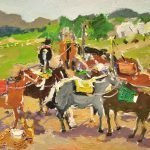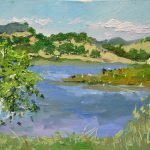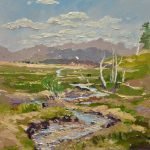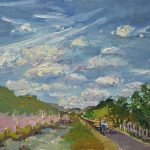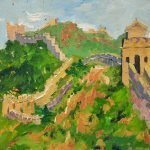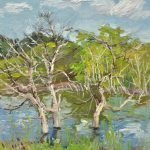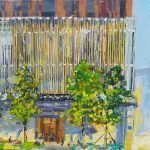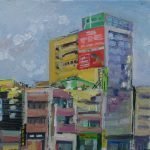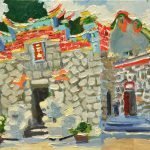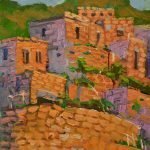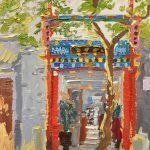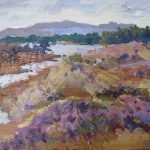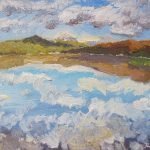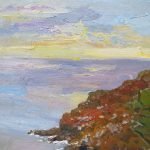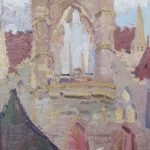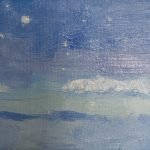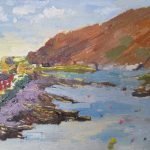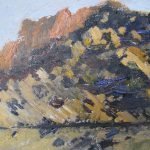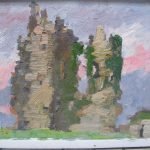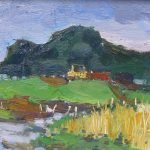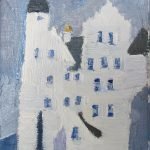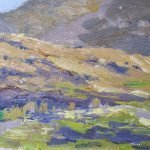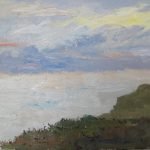My artistic practice has taken me through artist residencies in Beijing, Mongolia, Taiwan, and Ireland, each offering a unique spatial and cultural context that has reshaped my understanding of existence. These experiences mirror my previous explorations of movement, perception, and time—not only in terms of the physical transitions between places but also in the way artistic creation itself unfolds within shifting environments. The process of relocating, adapting, and responding to a new space resonates with Martin Heidegger’s notion that existence is not fixed but is shaped by our interactions with the world.
As an artist in residence, I find myself in a continuous state of becoming, embedded in spaces that are neither entirely foreign nor fully familiar. Each location presents distinct material textures, landscapes, and temporal rhythms that influence my creative process. The act of painting in residency is not merely a solitary endeavor—it is shaped by the environment, the people I encounter, and the layered histories of each place. This dynamic interplay between self and space echoes Heidegger’s “Being-in-the-world”, where human existence is not defined in isolation but emerges through its relationship with the surrounding world.
In Beijing, the weight of history and rapid urbanization collided in my work. The dense, shifting cityscape and the co-existence of past and present forced me to reconsider the temporality of human presence. I sketched and painted within the ever-changing architectural landscape, exploring how people navigate impermanence and continuity within an urban fabric that is constantly being demolished and rebuilt. The works produced here captured a city in flux, where historical memory lingers even as the physical world transforms daily.
In contrast, Mongolia offered an entirely different spatial-temporal experience. Here, space stretched into vast, open landscapes, and time seemed to flow differently—less dictated by rigid urban rhythms, more attuned to natural cycles and nomadic movement. My paintings became more expansive, more open, reflecting the vastness of the land and the fluid existence of those who inhabit it. Unlike the structured, permanent architecture of Beijing, the Mongolian environment challenged me to engage with ephemeral structures—yurts, seasonal migrations, and a culture deeply connected to movement rather than fixity. I began to question the idea of permanence in artistic creation, embracing a nomadic, transient approach to my work.
Returning to Taiwan, I was confronted with a different sense of place—one marked by intimacy, density, and layered cultural histories. Here, my work focused on small, personal spaces, capturing the textures of everyday life, interpersonal relationships, and urban rituals. Unlike Mongolia’s expansive openness, Taiwan’s landscape brought me back to the micro-level of human interaction—how people coexist within compact spaces, how bodies are positioned in relation to one another, and how architecture shapes daily behaviors. This residency became an inquiry into proximity, familiarity, and the negotiation of personal and collective spaces.
In Ireland, the residency experience was shaped by a deep engagement with myth, landscape, and historical time. Unlike the hyper-modern transformation of Beijing or the nomadic traditions of Mongolia, Ireland’s artistic atmosphere seemed deeply rooted in storytelling, folklore, and an embedded sense of place. I explored how landscapes hold memory, and how people construct their identities in relation to land, history, and mythology. My paintings here took on a dreamlike quality, weaving together natural elements, historical echoes, and the fluid boundary between reality and legend.
Across these different residencies, I came to recognize that artistic creation itself is a transient, adaptive process, shaped by the space, time, and cultural conditions of each location. Much like my earlier experiences of commuting and sketching, these residencies reaffirmed that existence is never static—it is always in movement, always being renegotiated in response to the surrounding world.
In the end, my work is not just about documenting these places but about questioning how we, as human beings, situate ourselves within an ever-changing world. Through painting, I attempt to capture the essence of presence within flux, asking: If our environment is always shifting, then what anchors us? Is existence itself a form of perpetual migration? Or does meaning emerge precisely from our ability to embrace change, to be in motion, to adapt?




